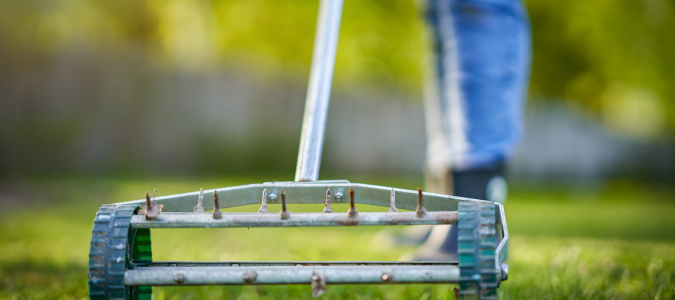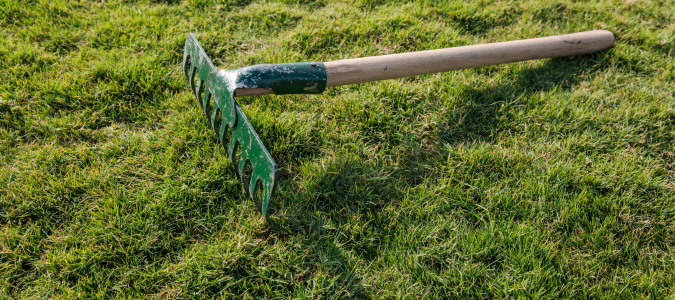Many homeowners are aware of the benefits of aerating their lawns. Lawn aeration allows for water, nutrients and air to reach your grass’s root system and aids in the overall health of your lawn. However, the thing that most homeowners do not know is that what you do after aerating your lawn is important, too.
To make the process effective, it’s smart to follow the proper post-aeration protocol. For example, watering your lawn after aeration can help keep your soil healthy, whereas raking your lawn after aeration can cancel out the benefits.
For the best outcome, contact a local lawn care specialist. They can handle the entire aeration process and follow-up maintenance for you.
What to Do After Aerating Your Lawn
Aerating your lawn is the process of poking tiny holes into your soil in order to loosen up compacted soil. There are several benefits to aerating your lawn, as it allows for water, nutrients and air to penetrate your grass’s root systems better. When your soil is too compacted, your grass does not get the vital elements it needs to survive and thrive.
However, to make the process worthwhile, it’s important to aerate your lawn properly and follow the correct next steps. It’s best to aerate our lawn in the spring and fall.
Right after you aerate your lawn, you must give it a thorough watering. Your soil will be much looser after you aerate your lawn, and loose soil can dry out faster than condensed soil. Dried-out soil will stress your grass and have the opposite effect of what you’re going for with aeration.
To avoid drying out your soil, water your lawn immediately after you aerate it. The water will help the soil settle and repair itself after aeration. You must give your lawn a deep watering, and the water should penetrate at least six inches into the soil.
This is to ensure that the water reaches your grass’s roots, which is where it’s needed the most after aeration. Water each section of your lawn for 20 to 30 minutes to ensure that it reaches at least six inches into your soil. However, the time it takes will depend on your soil and local climate.
Continue to water your lawn often after aeration. You want the soil to remain moist; however, be careful not to oversaturate your lawn. Again, consult with a lawn care service in your area for a personalized watering schedule after aeration.
In addition to thorough watering, you should take a few other steps after aerating your lawn to make the process effective. For example, post-aeration is a great time to overseed and fertilize your lawn.
Wait a few weeks before mowing your lawn after aerating it. Aerating may cause grass, soil and debris to pile up, but mowing too soon can damage your grass.
Finally, avoid heavy foot and vehicle traffic on your lawn for at least two weeks after aeration. The soil needs time to resettle, and traffic will cause further stress. Contact a lawn care specialist for more tips and best practices on lawn aeration.
Should My Lawn Be Raked After Aeration?
It’s tempting to rake your lawn after aeration, as the process leaves plugs of dirt all over your yard. However, avoiding temptation and leaving the plugs in your yard is important. When you remove them, you lose out on the vital nutrients that they can provide to the soil.
When you leave the soil plugs in place, the nutrients in the soil are recycled back into your lawn, which is beneficial for the health of your grass. Allowing the soil plugs to recycle back into your lawn boosts the benefits of the entire aeration process, which makes your efforts more worthwhile.
Another benefit to leaving the soil plugs on your lawn is that it allows for “soil conditioning” to occur. As the soil plugs slowly decompose and reintegrate into your lawn, it improves your soil’s overall structure, providing long-term health benefits for your grass.
Lastly, the soil plugs also encourage microbial activity, which helps to provide even more nutrients to your grass’s root system.
Aerating your lawn has several long-term benefits for your soil and grass health, and you get the most bang for your buck when you allow the excess soil plugs to reintegrate back into your lawn.
On the other hand, if you rake up the soil plugs, you risk damaging your lawn. Not only does your lawn lose the nutrients it could’ve gained from the soil, but raking your lawn after aeration can cause your loosened soil to compact again. This counteracts the aeration process and puts stress on your grass.
The benefits of leaving the soil plugs in your yard far outweigh your lawn’s short-lived messy appearance after aeration. Additionally, you save time and spare yourself the energy it would’ve taken to rake them up. Let nature do its job and decompose the soil plugs back into your lawn for increased nutrients and overall grass health.
Instead of raking your lawn after aeration, you should water and fertilize it. Contact a lawn care specialist for more guidance on proper lawn care post-aeration. An expert can provide personalized tips based on your lawn’s needs and get the entire job done for you.
ABC Can Care For Your Lawn
Lawn dethatching and aeration can be tricky if you don’t have the right tools and, without the proper experience, you can spend a long time and unknowingly damage your grass. Instead of taking that chance, let the lawn service professionals at ABC Home & Commercial Services take lawn aeration and dethatching off your plate. Not only can we help with this chore, but we can also take over your lawn mowing, fertilizing and watering so you can spend more time enjoying your yard as opposed to working on it.


